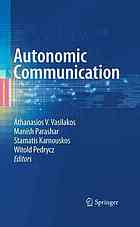

Most ebook files are in PDF format, so you can easily read them using various software such as Foxit Reader or directly on the Google Chrome browser.
Some ebook files are released by publishers in other formats such as .awz, .mobi, .epub, .fb2, etc. You may need to install specific software to read these formats on mobile/PC, such as Calibre.
Please read the tutorial at this link: https://ebookbell.com/faq
We offer FREE conversion to the popular formats you request; however, this may take some time. Therefore, right after payment, please email us, and we will try to provide the service as quickly as possible.
For some exceptional file formats or broken links (if any), please refrain from opening any disputes. Instead, email us first, and we will try to assist within a maximum of 6 hours.
EbookBell Team

4.4
102 reviewsNew paradigms for communication/networking systems are needed in order to tackle such emerging issues as heterogeneity, complexity and management of evolvable infrastructures, thus requiring approaches that are both task- and knowledge-driven. The networking and seamless integration of concepts, technologies and devices in a dynamically changing environment poses many challenges to the research community, including interoperability, programmability, management, openness, reliability, performance, context awareness, intelligence, autonomy, security, privacy, safety, and semantics. Inspired by biological systems, autonomic communication envisions communication systems that can organize, configure, optimize, protect, and heal themselves with minimal involvement of human administrators.
Autonomic Communication explores conceptual models and associated technologies that will uphold the vision of autonomic communication where devices and applications blur the boundaries between virtual and real worlds as they seamlessly interconnect, intelligently cooperate, and autonomously manage themselves.
Written by leading international researchers, the contributions give testimony to the challenges and prospects of this rapidly growing area. The volume is composed of chapters covering a wide range of issues related to autonomic communication.
Part I Autonomic Communication Infrastructure
Part II Autonomic Communication Services and Middleware
Part III Applications to Ad-Hoc (Sensor) Networks and Pervasive Systems
Autonomic Communication provides a vital reference to both researchers and practitioners, particularly those in networking, future and emerging technologies, mobile systems, autonomous technologies, computational intelligence, and embedded systems. The book is also a useful tool for graduate students and senior undergraduate students in courses on networking, autonomous management web, services, network application modeling, knowledge-based systems, and evolutionary software.